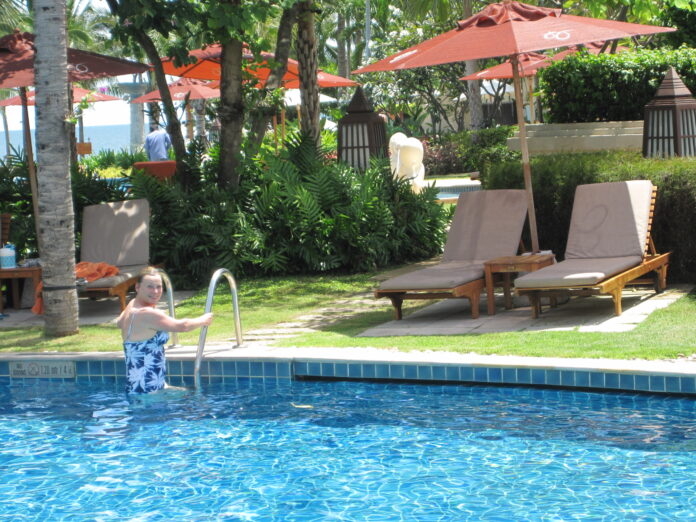Singapore announced it will open a segregated travel lane so “business, official, and high economic value travelers” can visit the city-state quarantine-free by staying in a designated “bubble” facility near the airport.
The facility, Connect@Changi, will feature guest rooms and conference rooms where visitors can meet with other people staying in the bubble. Travel lane visitors will be able to meet with Singapore residents in the bubble—but only with floor-to-ceiling dividers separating them.
The business travel lane is the latest attempt by Singapore’s government to jump-start the country’s all-important tourism and business travel sectors, which have cratered in the COVID-19 pandemic.
Tourism accounts for 4% of Singapore’s gross domestic product—it generated $20 billion in 2019—and the city is normally a top spot for business conferences and trade shows.
Over 19 million international tourists—more than three times the population of the country—visited Singapore in all of 2019, according to the Singapore Tourism Analytics Network. Through October, just 2.7 million visitors had trickled across the border in 2020.
Singapore largely has its coronavirus outbreak under control; it has not logged more than 20 new daily cases since the end of September. But its small size—the island nation spans 280 square miles—means that unlike its geographically bigger Asian peers that have also tamed COVID-19, Singapore can’t rely on domestic tourism to make up for the steep drop-off in international visitors.
“We don’t have a big domestic tourism market unlike, say, China or Hong Kong or Australia, and so the impact has been tremendous on our tourism industry,” Keith Tan, chief executive of the Singapore Tourism Board, said during a Fortune Global Tech Forum virtual conversation earlier this month.
In desperate bids to revive tourism and business travel, Singapore has rolled out a series of schemes—with varying degrees of success.
Domestic tourism
In June, as Singapore was loosening stay-at-home orders and other COVID-19 restrictions, the Singapore Tourism Board started letting popular tourist attractions reopen in stages and began accepting applications from domestic tour operators to resume business.
The following month, the board launched SingapoRediscovers, a $34 million campaign to boost local tourism, offering residents “staycation” packages, tours, and discounted attractions. That campaign included a $75 voucher for every adult Singaporean to use on hotels and attractions. On Dec. 1, the first day the vouchers were redeemable, the designated booking platforms received $1.4 million in sales.
Singapore’s renowned Jewel Changi Airport features a 16-meter Christmas tree this holiday season. Earlier this year, the Singapore Tourism Board encouraged residents to “travel” domestically by offering vouchers.
Suhaimi Abdullah—Getty Images
Singapore’s flagship carrier, Singapore Airlines, has also staged creative attempts to boost revenue and get some of its planes back in the air. (In October, it recorded a 98.2% year-on-year decrease in passengers carried.)
The airline toyed with the idea of “flights to nowhere.” Passengers would board a plane that took off from Singapore’s Changi Airport, fly around, and then land at Changi again. Airlines in Taiwan and Hong Kong have operated flights to nowhere, with some working better than others. The haze over Hong Kong on the day of the region’s inaugural flight to nowhere was so thick that passengers couldn’t see the city from the plane.
Singapore Airlines ultimately didn’t follow through on the flights to nowhere idea, opting instead in October for a grounded experience that offered customers dinner and a movie on a double-decker A380 plane for $37 to $440. The airline also began offering tours of its training center and use of its flight simulator.
Singapore did allow the Royal Caribbean cruise line to launch “cruises to nowhere” from its harbor, but last week one ill-fated ship returned to port a day early after a passenger tested positive for the coronavirus, despite upgraded air filters, mandatory testing, and other safety protocols that officials had required of the operator. (It’s still unclear when or where the passenger contracted the virus.)
Bubbles and lanes
In September, the city-state received the first passengers from Brunei and New Zealand under its Air Travel Pass program.
The scheme lets visitors—including leisure tourists—apply to travel to Singapore and do so without undergoing a 14-day quarantine. Since it launched the plan in September, Singapore has expanded the list of eligible regions to include Australia, China, Taiwan, and Vietnam. The scheme is unilateral, meaning Singaporeans who want to travel to those countries are still subject to existing coronavirus travel restrictions.
Royal Caribbean’s Quantum of the Seas cruise ship docked at the Marina Bay Cruise Centre in Singapore on Dec. 9, 2020, after a passenger on a “cruise to nowhere” tested positive for COVID-19.
Ore Huiying—Bloomberg/Getty Images
Singapore also runs reciprocal “green lane” programs with China, South Korea, Indonesia, Malaysia, Japan, Brunei, and Germany that let some corporate and diplomatic travelers skip quarantine on arrival if they test negative for COVID-19.
But Singapore still hasn’t managed to open a travel bubble with another region that would allow tourists from both sides to travel back and forth without quarantining.
In late November, it very nearly pulled off a travel bubble with Hong Kong that would have let residents of each region travel quarantine-free to the other, but a fourth wave of coronavirus cases in Hong Kong thwarted the bubble and forced authorities to delay it until at least 2021.


























